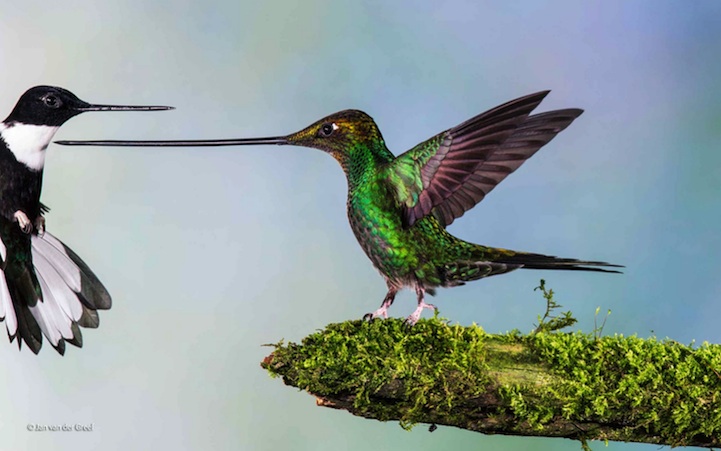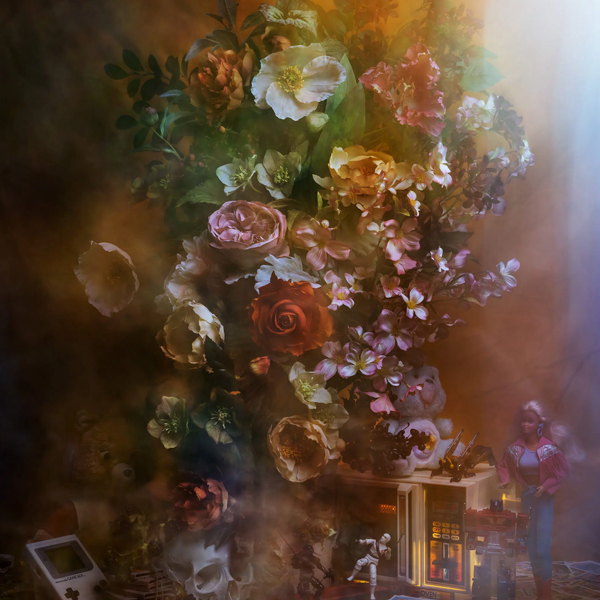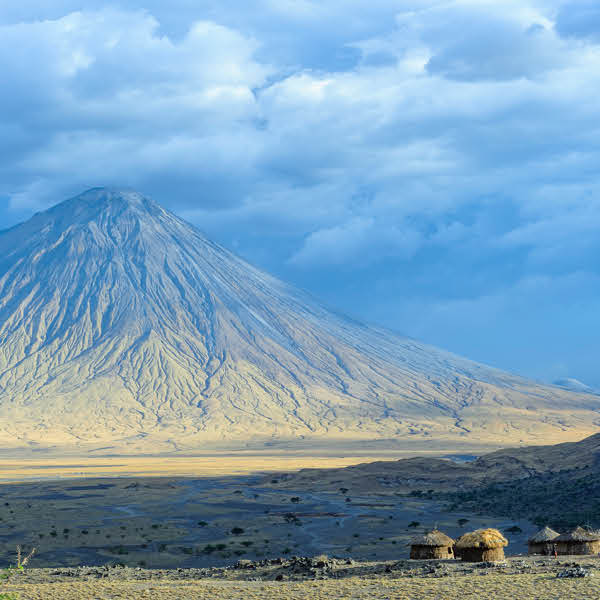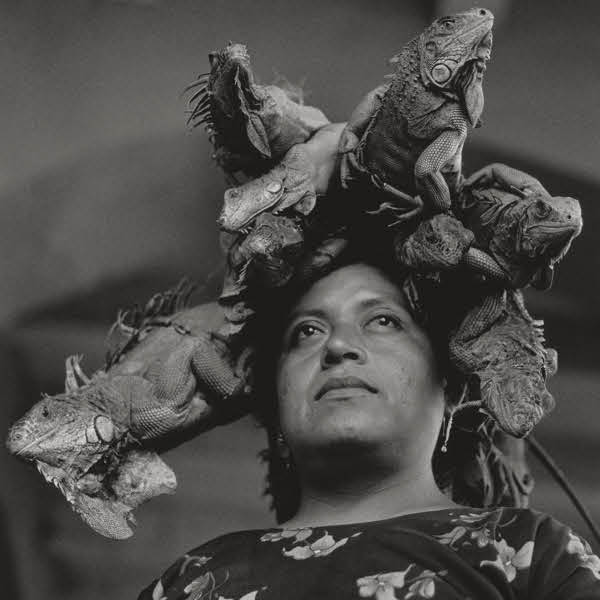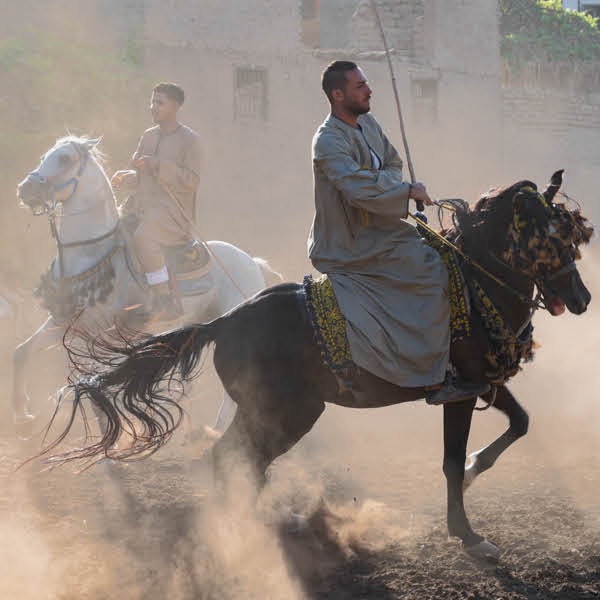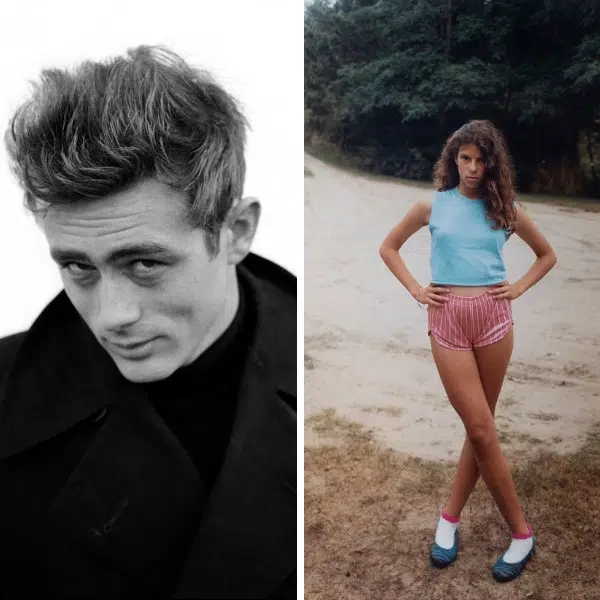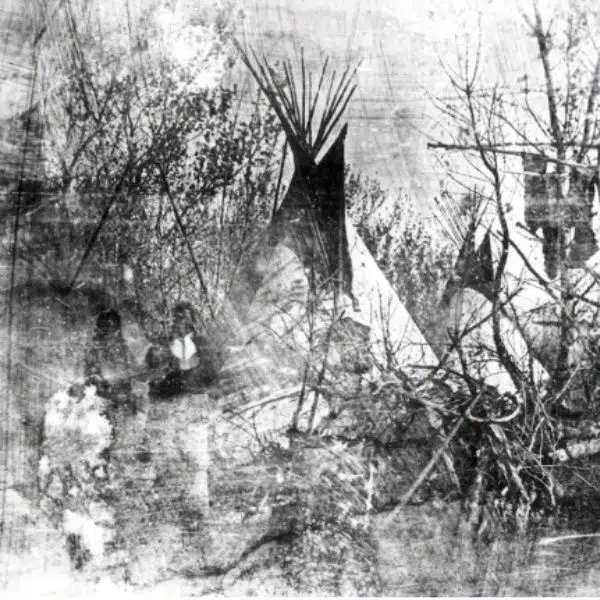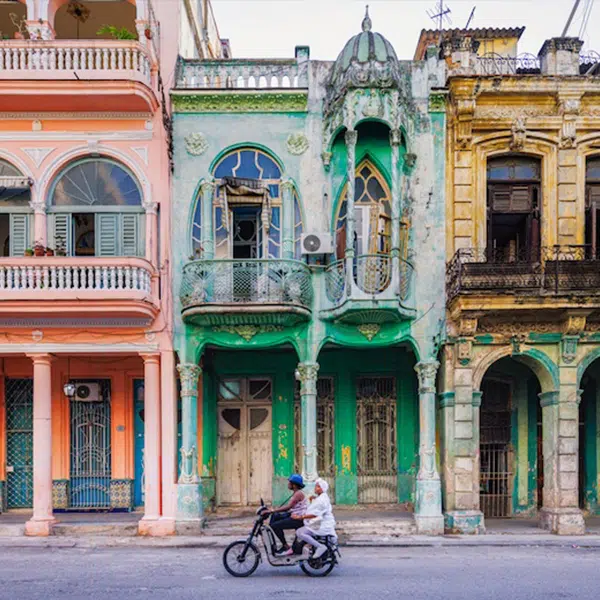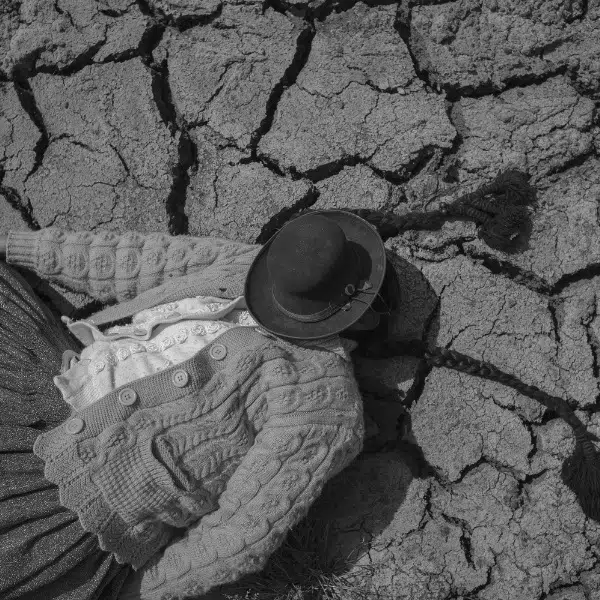Winners of the Wildlife Photographer of the Year Awards were recently announced and the photos are better than ever! The competition, which is put on by the Natural History Museum and BBC Worldwide, is one of the exciting photo competitions around because of all of the great entries. This year, they received more than 42,000 from 96 countries.
The top prize, claiming the Wildlife Photographer of the Year 2014 title, went to Michael ‘Nick' Nichols for his incredible black and white photo of lions in the Serengeti sleeping. “They were used to Nick's presence?as he'd been following them for nearly six months, so he could position his vehicle close to the kopje. He framed the vista with the plains beyond and the dramatic late afternoon sky above. He photographed the lions in infrared, which he says ‘cuts through the dust and haze, transforms the light and turns the moment into something primal, biblical almost'. The chosen picture of lions in Africa is part flashback, part fantasy…”
Now, here are some of our favorites. They include both winners and finalists.
Finalist, Birds: Touch
The focus of Jan's trip to Ecuador was the astonishing sword-billed hummingbird, the only bird with a bill longer than its body (excluding its tail). Its 11-centimetre bill is designed to reach nectar at the base of equally long tube-shaped flowers – but Jan discovered that it can have another use. One particular bird had a regular circuit through the forest, which took in its favourite red angel trumpet flowers and the bird feeders near Jan's lodge. To get to the bird feeders, it had to cross the path of a fiercely territorial collared inca hummingbird. Rather than being scared off, the sword-billed hummingbird used its bill to make a statement once or twice a day. To capture one of these intensive yet colourful stand offs, Jan set up multiple flashes to freeze the hummingbirds' wing-beats, of which there are more than 60 every second.
Photo: Jan van der Greef, The Netherlands
Winner, Mammals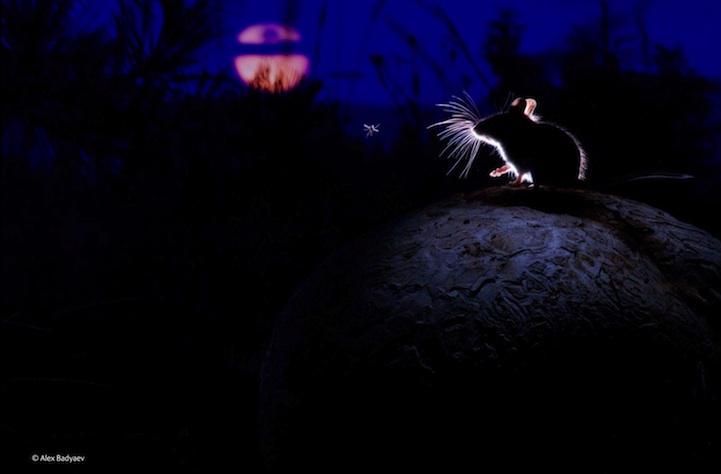 The Mouse, the Moon and the Mosquito
The Mouse, the Moon and the Mosquito
Alexander was taking his daily hike along a trail in the Blackfoot Valley, western Montana, USA, when he noticed a giant puffball mushroom starting to inflate. Squirrels, chipmunks and mice began exploring and scent-marking the surface of the oversized fungus leaving it covered with tiny prints. Alex returned to the spot during a full Moon, when the puffball had reached its maximum size. He lay on the ground, watching and waiting, entertained by the dozens of small animals exploring the puffball. The most frequent visitors were deer mice, which scampered around, sometimes pausing to check on their surroundings. To avoid disturbing the animals, and to preserve the sense of place, Alex used the Moon as his backlighting. He relied on a long exposure and a gentle pulse of flash to show the curve of the fungus and to capture the frantic activity. When one deer mouse paused for a moment to investigate a persistent mosquito, the perfect midnight puffball scene was created.
Photo: Alexander Badyaev, Russia/USA
Finalist, Mammals 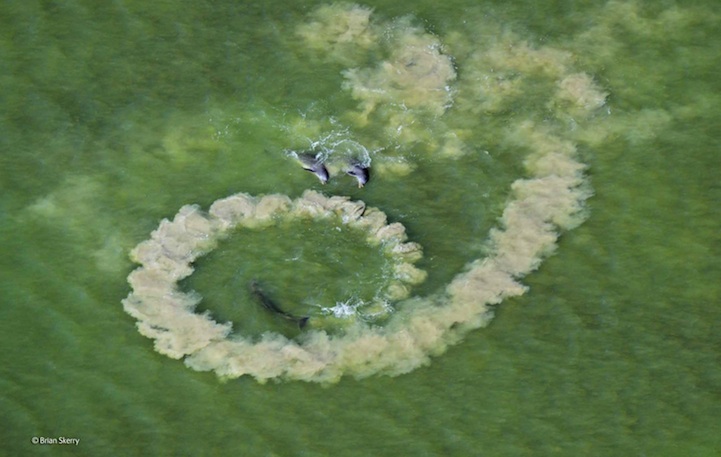 Creative Dining
Creative Dining
The extraordinary mud-ring hunting technique of bottlenose dolphins is known to occur only in Crystal River and Florida Bay, Florida, USA. Brian headed for the bay, hoping to photograph this rare behaviour as part of a project on intelligence. The shallows over the mudflats are rich feeding grounds for dolphins, which use sonar to locate their prey, mainly mullet. They emit clicks that are sent out as a beam of sound. When the beam hits an object in the water, the sound is bounced back to the dolphin as an echo, which is used to locate the object. When a shoal is detected, one dolphin circles it, striking the mud with its tail to create a wall of muddy water around the prey. As the wall starts to dissipate, the panicking fish leap out of the water towards the rest of the dolphins, which line up to snatch the fish from the air. To capture the dolphins in the act, which takes just seconds, presented a challenge. Working from a helicopter with a dolphin researcher, Brian spotted the moment when the lead dolphin completed a perfect ring, and its two accomplices jumped up, mouths agape, ready to grab a meal.
Photo: Brian Skerry, USA
Finalist, Mammals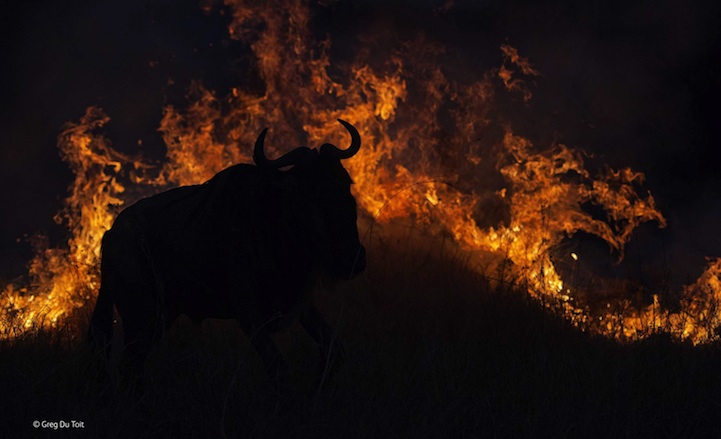 Fleeing the Flames
Fleeing the Flames
Greg was on safari with friends in Tanzania's Serengeti National Park when he spotted smoke. It came from a grass fire sweeping across the plain. Driving towards it, he saw a lone wildebeest, seemingly reluctant to move. Its leg was broken. As the blaze approached, he watched in horror. ‘It was incredibly hot and smoky, but we stayed, willing the animal to leave'. Finally it did, just as the flames were lapping at its tail. He took the shot as part of a bigger story on wildebeest migration. Every year around 1.3 million animals move from the Serengeti to Kenya's Maasai Mara National Reserve and back in search of food and water. Many perish on the journey, often drowning at river crossings, succumbing to fires, or becoming prey for hyenas or lions. ‘I want to portray some of the challenges they face,' explains Greg. Though this animal escaped the flames, its fate is still uncertain.
Photo: Greg Du Toit, South Africa
Winner, Birds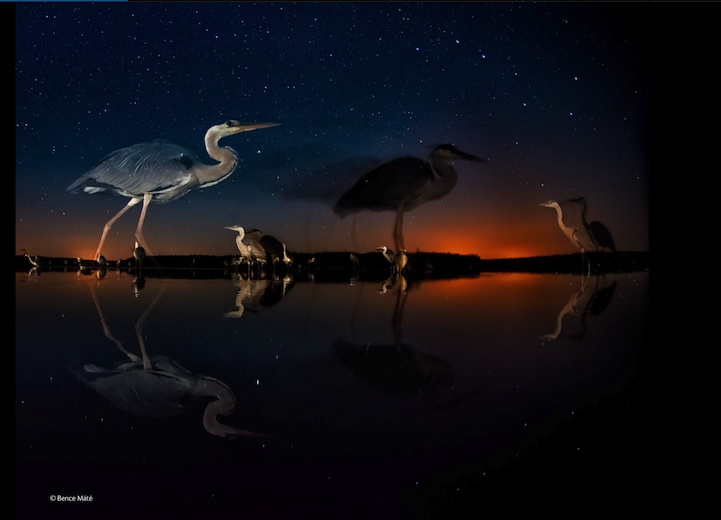 Herons in Time and Wpace
Herons in Time and Wpace
Bence had set up his hide to overlook Lake Csaj in Kiskunsg National Park, Hungary. He had a specific image in mind and had planned to use both artificial and natural light. His subject was the shy grey heron. To overcome the various technological challenges of a night-time shot, he had built two timing devices for his camera to execute the single exposure. One device moved the focus, while the other adjusted the aperture within a single frame, so both the herons and the stars were in focus. It took 74 nights in the hide before the conditions were right and it all came together. The surface of the lake was still, reflecting the stars, and the sky was clear and motionless. Just after midnight, the seven stars of the Plough (part of the Ursa Major constellation) slid into position above the glow of a distant town. Bence took the shot, with both the stars and herons sharp, but with traces of the birds' movement leaving ghostly impressions against the sky. Blending technology and passion in a masterful manner, Bence had finally created a picture that he had planned for many years – of herons imprinting their images in time and space.
Photo: Bence Mt, Hungary
Finalist, Birds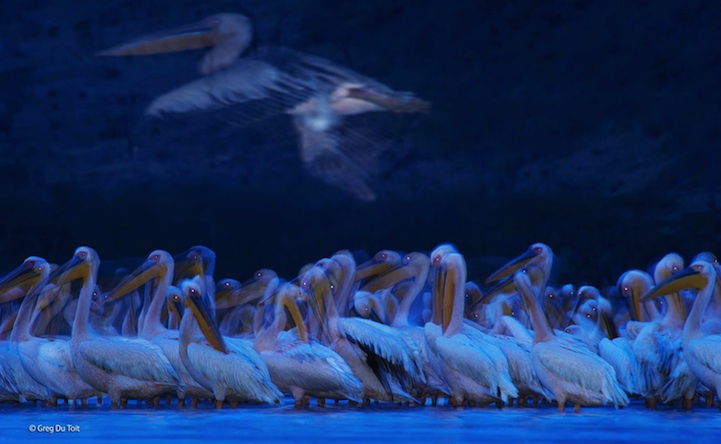 Night of the Pelicans
Night of the Pelicans
Greg's car had broken down – he was alone in the bush and it was getting dark. But the location was perfect. Stranded on the edge of Kenya's Lake Nakuru, he could see about 200 great white pelicans settling down to roost. To get a view from the birds' eye level, he lay down at the lake's edge (alert to the danger of emerging hippos) and composed his shot. He decided on a long exposure to capture the atmosphere and timed it to include a pelican flying in. ‘I would look down the valley to see if one was approaching. When I figured it was about three seconds away from being in the frame, I tripped the shutter.' A burst of flash was just powerful enough to create the ghostly impression of one of the stragglers, with the last of the ambient light reflected off the Rift Valley wall behind.
Photo: Greg Du Toit, South Africa
Finalist, Birds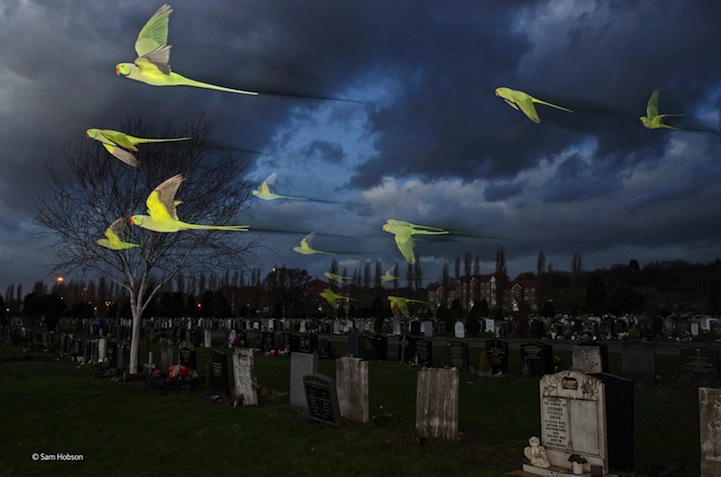 Feral Spirits
Feral Spirits
Just before dusk fell over London, the birds would start to appear. Sam says there were ‘swarms of them coming in low across the cemetery, heading for their roost in the trees just behind me. I'd keep having to duck.' Ring-necked parakeets, an Afro-Asian species, are now well established in the wild in Britain – the result of escapes and deliberate releases from captivity – and they are thriving in London. Their winter roosts can be huge – Sam had checked out several before opting for this one. ‘There were probably 5,000 birds – the noise was amazing,' he says. With a constant stream of arrivals squawking past in groups of 20 or30, Sam worked out the parakeets' typical flight paths. He set up his kit, experimented with various techniques and realised they were coming close enough for him to use a wide-angle lens. With a burst of flash at the end of a long exposure to create their ghostly trails, Sam captured the essence of these eye-catching aliens in the English urban landscape. By the time it was dark, an hour and a half after the first arrival, the fly-past of thousands was complete.
Photo: Sam Hobson, United Kingdom
Winner, Amphibians and Reptiles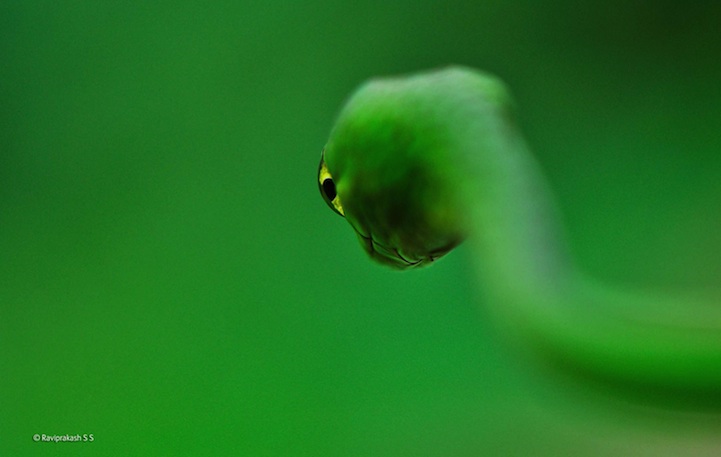 Divine Snake
Divine Snake
During the Indian monsoon season, green vine snakes often venture near houses. In this case one slithered just a few metres away from Raviprakash's front door in Karnataka, in the heart of the Western Ghats. The snakes are attracted by the lizards and frogs that shelter among the vegetables and flowers in his garden. In the past two or three years he has ‘mastered the skill of identifying them amid a mass of green'. This snake appeared to be a plant at first glance – it was even swaying in the breeze. ‘A vine snake tends to spend a considerable amount of time in the same location,' says Raviprakash. ‘It will wait for prey with divine concentration,' before freezing in position once it has its prey in sight. The main challenge was to show the snake from this unusual perspective, without disturbing its concentration. Raviprakash says, ‘The green vine snake is one of the most beautiful creatures I have ever seen. Each time I photograph one, it looks ever more beautiful.'
Photo: Raviprakash S S, India
Finalist, Amphibians and Reptiles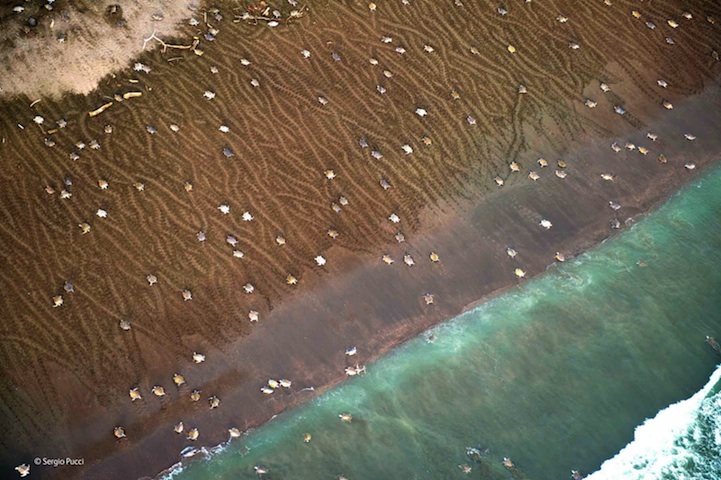 The Great Arrival
The Great Arrival
The mass nesting, or arribada, of hundreds of thousands of olive ridley sea turtles occurs at Costa Rica's Ostional National Wildlife Refuge once or twice a year. The endangered turtles arrive from their feeding grounds to mate offshore, and the females then haul themselves up the beach to lay their eggs. Sergio witnessed his first arribada when he was 10. Over the years he has photographed the spectacle many times but, until now, never from the air. Its timing is unpredictable, and it usually peaks at night. For five years Sergio tried to get his dream aerial shot taking off in the dark in an ultralight autogyro so as to be overhead at first light. Arriving at the shore in the early hours to take this shot, he found the beach empty – – all the turtles were in the ocean. When he returned that afternoon, they had crawled back onto sand and he finally had his chance. He focussed on the pattern of their tracks on the wet sand as a way of representing the multitude.
Photo: Sergio Pucci, Costa Rica
Finalist, Amphibians and Reptiles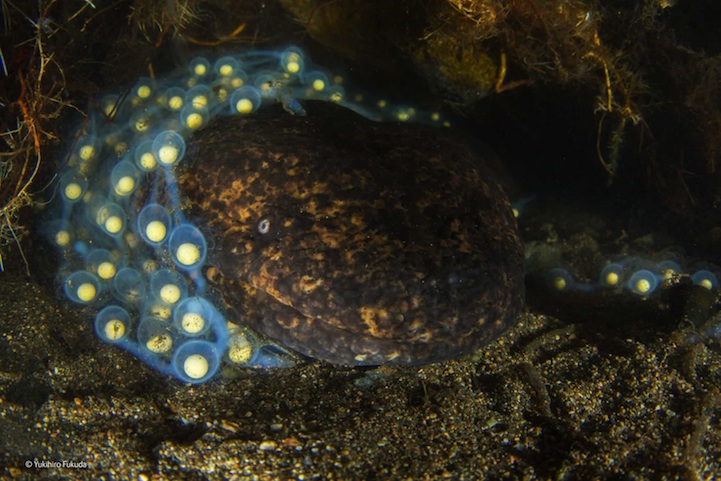 Big Daddy
Big Daddy
It took Yukihiro six years to get this shot of a male Japanese giant salamander guarding eggs in its den. This mighty amphibian – up to 1.5 metres long – is unique to Japan. It is a national symbol, the stuff of legends and protected as a Special Natural Monument, but its natural behaviour has seldom been photographed. Hunting small prey in streams and rivers by night and hiding among rocks by day, giant salamanders are extremely difficult to locate. Finding one in a spawning burrow is even harder, but that was what Yukihiro set out to do as part of his project to illustrate the giant's ecology. The males compete, sometimes viciously, for the best spawning sites, usually burrows, holes or pits in the sand. In late August the females will lay their eggs, between 400 and 500 of them, joined together like strings of beads. The males look after the eggs until they hatch in mid-October, and then guard the larvae until early spring. As soon as spawning began in the Hino River in southwest Japan, Yukihiro went diving for up to 10 hours every day in search of the action. The most difficult part was finding a spawning burrow. He finally captured this portrait of the father in its hiding place, soon after the female had left it with the clutch of eggs.
Photo: Yukihiro Fukuda, Japan
Winner, Invertebrates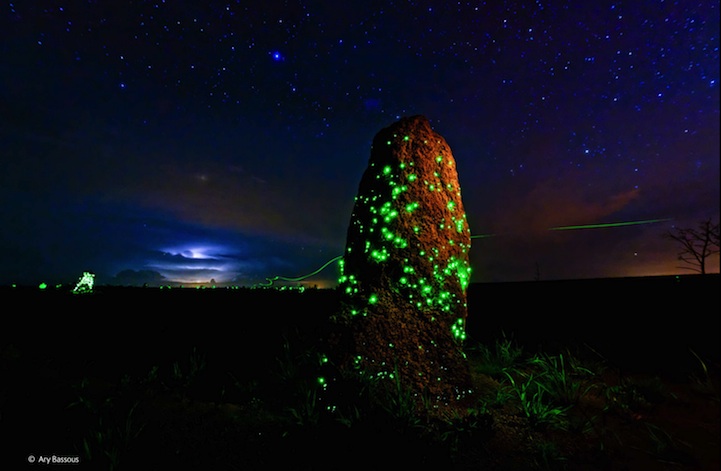 Night of the Deadly Lights
Night of the Deadly Lights
On still, humid nights, the old termite mounds on the savannah of Emas National Park, central Brazil, sparkle with eerie green lights. These are the bioluminescent lures of click beetle larvae living in the outer layers of the mounds. When conditions are right, they poke out of their tunnels. Shining their ‘headlights', they wait for prey – usually flying termites that emerge on humid evenings to mate and look for new places to colonise. Ary lit this mound with a flashlight and kept the shutter open for 30 seconds to blur the insects' flashes. This resulted in small pools of intense colour if the larvae remained still, or starbursts if they wriggled. Some adult beetles were flying, painting their flight paths against the starry sky. The orange glow of two towns and streaks of lightning were visible in the distance. To catch the peak of the phenomenon, which occurs after the first wet season rains and lasts for only a couple of weeks, Ary would stay in the park overnight. Despite occasional 'bouts of crippling fear' at the thought of jaguars and other dangerous animals that might be out after dark, he says the experience and resulting pictures were worth it. He achieved a shot he had been trying to capture for nearly a decade.
Photo: Ary Bassous, Brazil
Finalist, Invertebrates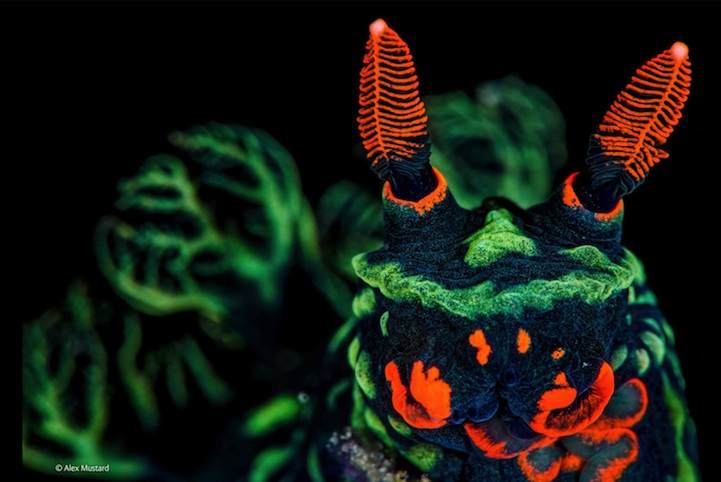 You Have Been Warned
You Have Been Warned
When Alex went diving in the Lembeh Strait in North Sulawesi, Indonesia, he was on a mission to celebrate the smaller sea creatures. Equipped with a new high-magnification lens, he encountered this variable neon nudibranch, a species of sea slug, crawling across the seabed. Less than two centimetres long, it has green gills on its back and orange mouthparts. It uses its orange, feather-like rhinophores to smell out its prey, primarily sea squirts. It incorporates distasteful chemicals from sea squirts' skin into slimy mucus, and uses its neon colours to warn predators that it tastes bad. Alex wanted an eye-level view of this unforgettable mollusc. But even with a small aperture it was a challenge. There was little depth of field and the subject was moving – and even a slug's pace under magnification is surprisingly fast.
Photo: Alex Mustard, United Kingdom
Finalist, Invertebrates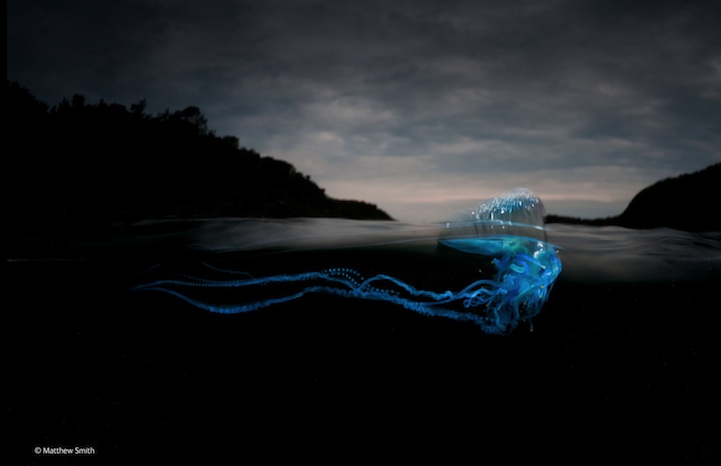 Sailing By
Sailing By
Thousands of Portuguese men o' war are blown onto the coast of New South Wales, Australia, during strong winds. These cnidarians are floating colonies of four kinds of organisms dependent on one another for survival. Rafts of them trapped in a sheltered bay provided a chance for Matt to photograph them. On this attempt – one of many – he was in the water at sunrise to catch the eerie light and the clearer water brought in by high tide. A breeze pushed the animals along like tiny sailing boats, making framing tricky. Despite his wetsuit, Matt didn't manage to avoid being stung. But the main problem was lighting. Strobes weren't an option as they illuminated all the particles in the water. So he used fibre optic snoots, pinpointing the light and bringing out the luminosity and beauty of an often unappreciated creature.
Photo: Matthew Smith, United Kingdom/ Australia
Winner, Plants and Fungi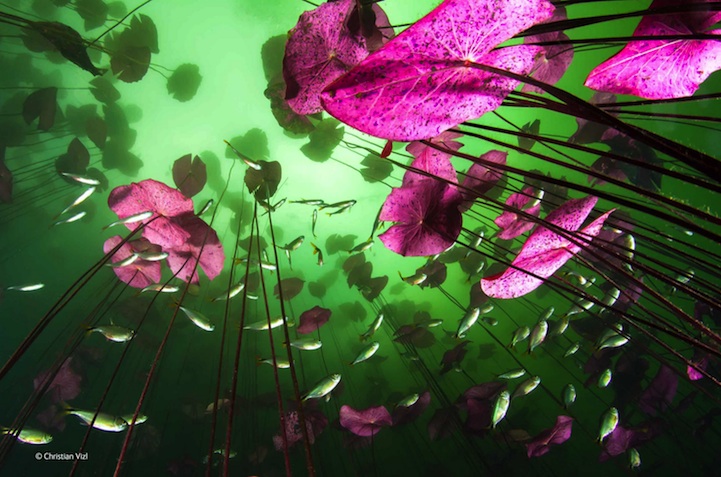 Glimpse of the Underworld
Glimpse of the Underworld
Water lilies stretch up to the light through a layer of green mist in the Aktun Ha cenote, a huge sinkhole on Mexico's Yucatn Peninsula. Aktun Ha is part of a great ring of thousands of cenotes, created when the limestone bedrock collapsed to expose the subterranean groundwater. Christian has been photographing the cenotes for the past 10 years. What makes Aktun Ha special is its underwater garden. The water is crystal clear, except in summer when an algal bloom several metres thick can develop beneath the surface. Christian settled on the bottom of the cenote to compose a picture of this still, silent underworld garden. The challenge was to balance the artificial with the natural light. The intensity and angle of the strobe illumination had to be just right. He wanted to bring out the texture of the leaves, flushed pink through ageing, without detracting from the natural light filtering down through the algae, or overexposing the skittish silvery fish. The resulting picture hints at why the ancient Maya considered cenotes to be sacred places and thought of water lilies as plants of the underworld.
Finalist Plants and Fungi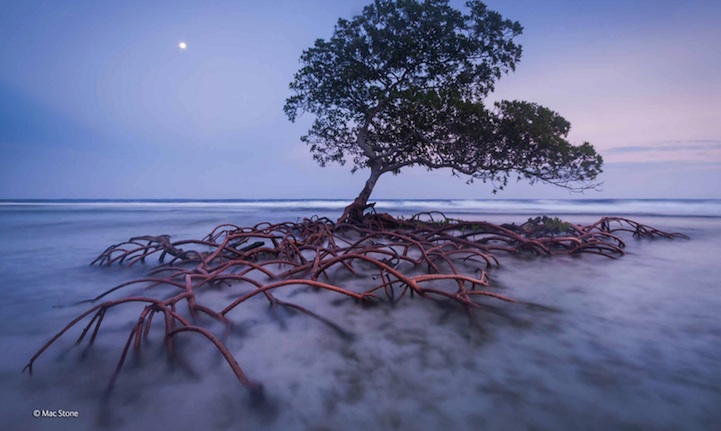 Beach Guardian
Beach Guardian
In 1998, Hurricane Mitch demolished most of the older red mangroves of Pig Keys off the Caribbean coast of Honduras. Mac discovered this survivor while exploring the area. Of all mangrove species, the red mangrove grows closest to the sea. Its supportive prop roots can withstand tidal waves and submersion in salt water. The thickets of roots shelter many marine animals and also help protect the coast, dissipating the energy of storm waves. For Mac, the surviving tree ‘not only symbolises the beauty of this coast but also the strength and endurance of the people who live there'. Bad weather prevented him from taking the shot he wanted on his first visit, so he made the difficult trip again a few months later. ‘You need permission, a boat to cross choppy open ocean and plenty of gear – there is no running water or electricity,' he says. At dusk, with the full Moon rising, Mac had his chance. ‘I wanted the tree to stand out, especially the roots,' he explains. ‘So I used a polarising filter to cut glare, a wide-angle lens to exaggerate the arches, and a long exposure to smooth the water.' The next day, a great storm came through, forcing him to leave once more.
Photo: Mac Stone, USA
Finalist Plants and Fungi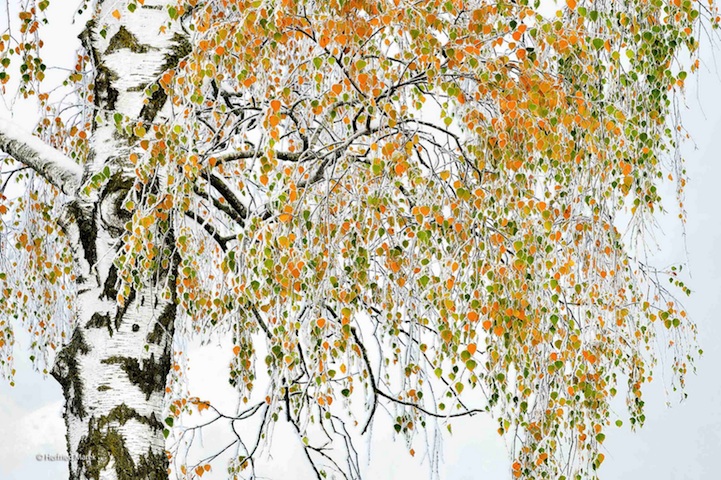 Golden Birch
Golden Birch
When Herfried woke one October morning and looked out of the window of his home in Wrschach, Austria, he was taken by surprise at the transformation. Everything was covered with a thin blanket of white. Heading straight out ‘to capture some of the magic' with his camera, he found one of his favourite silver birches glowing through a dusting of fresh snow. The green and gold diamond-shaped leaves were delicately edged with frost. The pattern of the leaves softly cascading down the slender, snow-covered twigs was offset by the solid trunk, its silvery-white bark cracked with age and encrusted with lichen and algae. Framing and reframing, he finally settled on a composition. The ethereal quality of the picture was enhanced by the white backdrop of freezing fog.
Photo: Herfried Marek, Austria
Finalist Plants and Fungi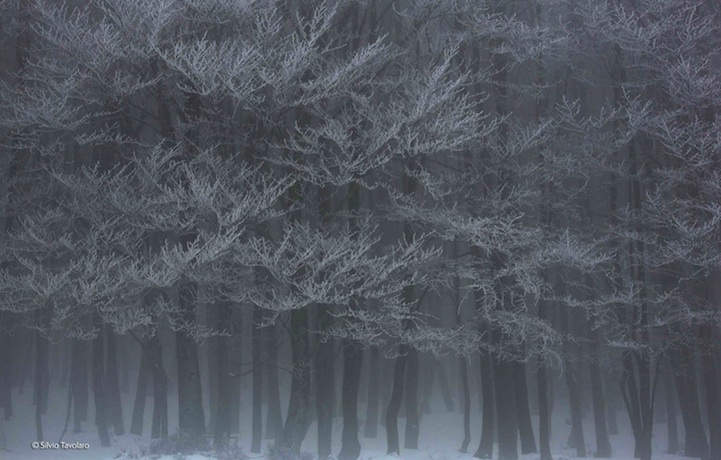 Snow Stand
Snow Stand
On a freezing winter's day, Silvio was driving home across Monte Livata, Lazio, in the heart of Italy, when a stand of beeches caught his eye. It had just stopped snowing, and the branches of the trees were delicately edged in white. He stopped the car to take in the atmosphere and beauty of the scene. In summer, the beech-leaf canopy blocks out the sun, preventing all but the most shade-tolerant species from growing beneath, but for now, snow had found its way through to carpet the woodland floor. ‘I was struck by the silence and wanted to convey the sense of peace and lightness.' Resting his camera on the car door and adjusting the exposure to bring out the contrast between the snow-clad branches and the trunks in the darkness below, he captured the stillness of the moment, before continuing on his way.
Photo: Silvio Tavolaro, Italy
Winner, Underwater Specis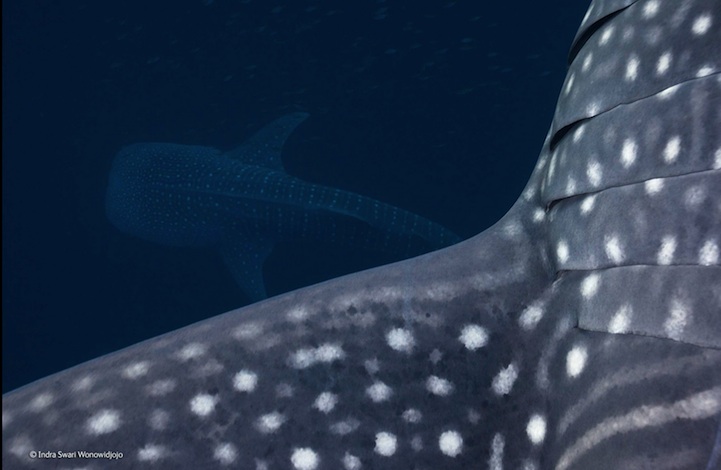 Passing Giants
Passing Giants
During a new Moon, the lights from the bagans (semi-mobile fishing platforms) in Cenderawasih Bay in Irian Jaya, Indonesia, attract shoals of fish into the nets of local fishermen. The lights act as a signal to filter-feeding whale sharks, which have learned to suck on the nets to extract the fish. It's an easy meal, so easy that the whale sharks sometimes need to be shooed away from the nets, though some fishermen will feed them. Up to 10 whale sharks can cruise around a bagan at any one time, and the location is now becoming a dive hotspot. Attracted by the spectacle, Indra spent a few days diving there. As a huge whale shark – at least nine metres long – glided by on one dive, she noticed another swimming a little deeper, in a different direction. She swam quickly to position herself above both of them when their paths crossed. She adjusted her strobe output and ISO so the great fish would both be sufficiently illuminated. ‘The sharks will happily swim straight into you, gently nudging you out of their way,' she says. ‘The fishermen see them as good omens and often jump in and swim with them.' Elsewhere in Asia, these massive animals, the world's largest fish, continue to be hunted.
Photo: Indra Swari Wonowidjojo, Indonesia
Finalist, Underwater Specis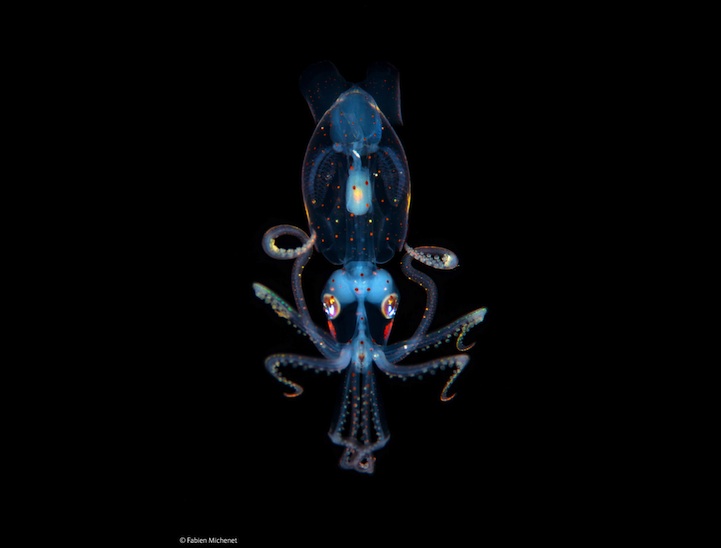 Little Squid
Little Squid
Planktonic animals like this juvenile sharpear enope squid are usually photographed under controlled situations after they've been caught. But Fabien is fascinated by the beauty of their living forms and aims to photograph their natural behaviour in the wild. Night diving in deep water off the coast of Tahiti, he was surrounded by a mass of tiny planktonic animals. Apart from the occasional sound of a dolphin, it was silent, and he became fascinated by this tiny squid. Just three centimetres long, it was floating motionless about 20 metres below the surface. It was probably hunting even smaller creatures that had migrated up to feed under cover of darkness. Its transparent body was covered with polka dots of pigment-filled cells, and below its eyes were bioluminescent organs. Knowing it would be sensitive to light and movement, Fabien gradually manoeuvred in front of it, trying to hang as motionless as his subject. Using as little light as possible to get the autofocus working, he finally triggered the strobes and took the squid's portrait before it disappeared into the deep.
Photo: Fabien Michenet, France
Finalist, Underwater Specis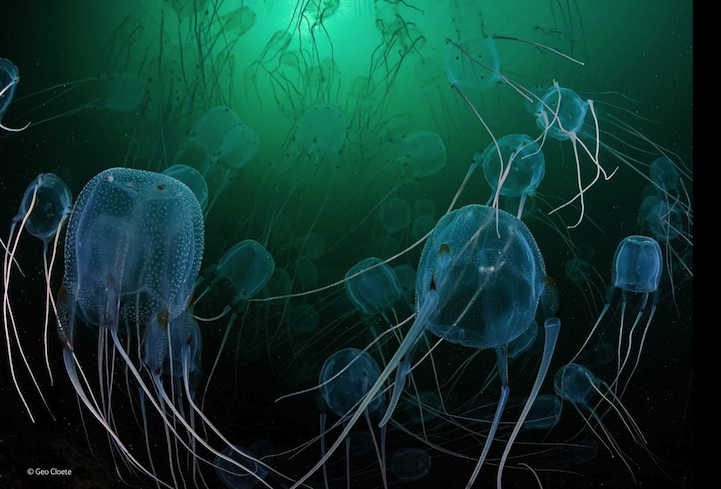 Jelly Fireworks
Jelly Fireworks
Geo never forgot the vast swarm of box jellyfish he encountered when diving in Hout Bay off Cape Town, South Africa. He had no camera then, but the experience sparked a passion for jellyfish. He fantasised about creating a picture of a huge mass of them, moving ‘like a firework display in slow motion', their tentacles like star trails. Though Geo occasionally found small groups of box jellyfish around South Africa's Cape Peninsula, it was seven years before he came across another mass gathering. It was in exactly the same location, in water cloudy with plankton. The 500 or so tightly packed cube-shaped bells would shoot forward when they saw him. Though these small jellyfish have no central nervous system, they have clusters of eyes on the four sides of their bells so, unlike most other jellyfish, they can jet away. ‘Visibility was bad, and so I needed to manoeuvre them so that they were nearer the surface and I could look up at them and outline them against the sunlight,' Geo says. Swimming into the mass, he braved the stings from their tentacles. With skilful positioning of his strobes to light rather than bleach those in the foreground, he managed to capture the otherworldly image he had in mind.
Photo: Geo Cloete, South Africa
Winner, Earth's Environments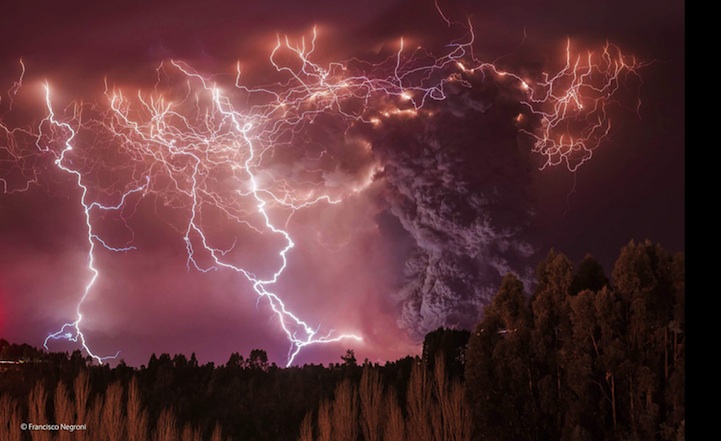 Apocalypse
Apocalypse
As the Puyehue-Cordn Caulle volcanic complex began erupting, Francisco travelled to Puyehue National Park in southern Chile, anticipating a spectacular light show. But what he witnessed was more like an apocalypse. He watched, awestruck, from a hill quite a distance to the west of the volcano. Flashes of lightning lacerated the sky, while the glow from the molten lava lit up the smoke billowing upwards, illuminating the landscape. ‘It was the most incredible thing I've seen in my life,' Francisco says. Volcanic lightning (also known as a dirty thunderstorm) is a rare, short-lived phenomenon. It is probably caused by static electrical charges resulting from fragments of red-hot rock, ash and vapour crashing together high in the volcanic plume. The Puyehue-Cordn Caulle eruption spewed 100 million tonnes of ash high into the atmosphere, causing widespread disruption to air travel in the southern hemisphere. Volcanic activity continued at a lesser level for a year, spreading a layer of ash over the region.
Photo: Francisco Negroni, Chile
Finalist, Earth's Environments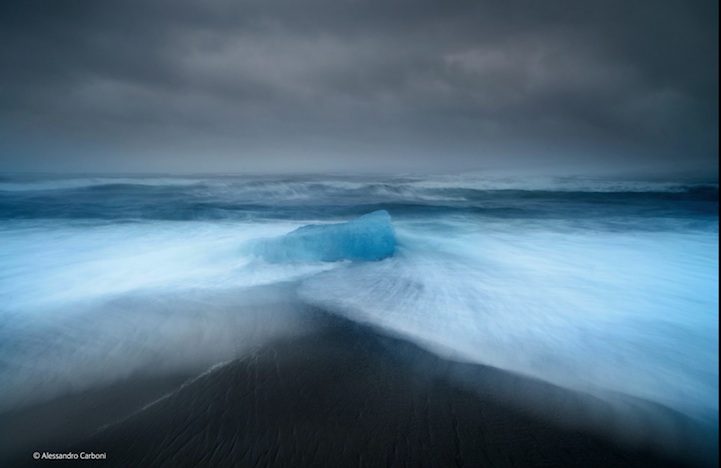 Ice Land
Ice Land
Alessandro decided to visit Iceland, a ‘place of fire, ice and stormy seas', very different from his Mediterranean homeland of Sardinia. He travelled to Jkulsrln, a glacial lagoon famous for its blue ice. He wanted to convey the remoteness, the power of the elements, and the beauty of the colours. Focussing on a single block of ice stranded on the volcanic beach, he set it centre frame. Using a long exposure and low-level view, he concentrated on the pattern of black sand left by the withdrawing surf. High winds and spray meant it took many attempts to capture both the pull of the ocean and the subtle colour contrasts of sky, sea and ice.
Photo: Alessandro Carboni, Italy
Finalist, Earth's Environments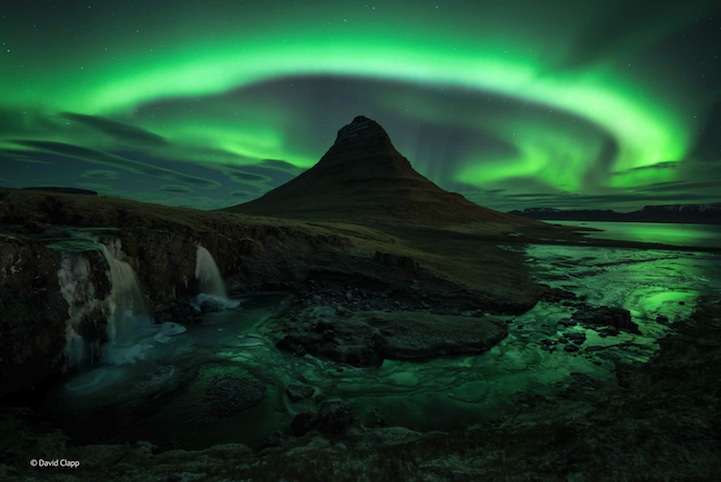 Magic Mountain
Magic Mountain
David had travelled to Iceland partly to photograph the auroras, choosing to visit the Snaefellsnes peninsula because of its spectacular scenery. He had first set up by the frozen river below Mount Kirkjufell, but when the show intensified he scrambled up the bank to a pre-planned viewpoint with the mountain as the focus. At 2am, the intensity of the aurora light suddenly changed and a great burst pulsed across the sky in a totally unexpected formation. The aurora colour is the result of collisions between electrically charged particles from space and oxygen and nitrogen atoms high up in Earth's atmosphere. David concentrated on the light behind the mountain, carefully composing the shot to create the illusion that curtains of light encircled the peak. As the light intensified, so did the contrast. ‘I slightly underexposed the image to avoid burning out the highlights, and painted light on the foreground with my head torch,' says David. The otherworldly lenticular clouds hovering over the waterfall and the green light reflecting off the frozen river added some extra magic to the scene.
Photo: David Clapp, United Kingdom
Wildlife Photographer of the Year 2014, Winner, Black and White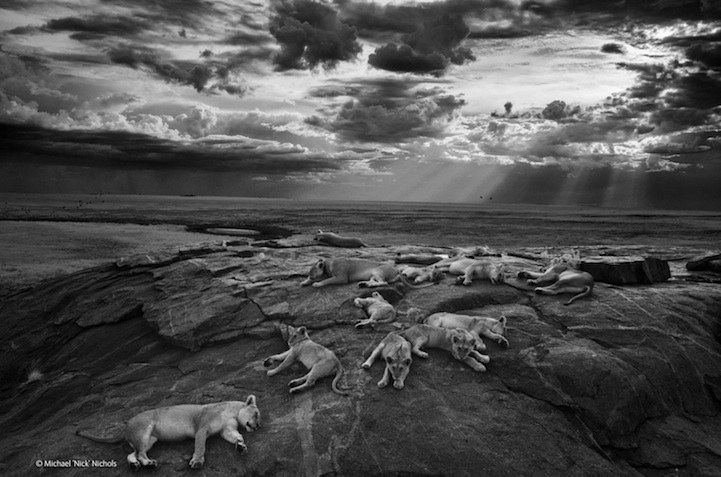 The Last Great Picture
The Last Great Picture
Nick set out to create an archetypal image that captured the essence of lions in a time long gone, before they were under such threat. The Vumbi pride in Tanzania's Serengeti National Park are a ‘formidable and spectacularly co-operative team,' Nick says. Here the five females lie at rest with their cubs on a kopje (a rocky outcrop). Shortly before he took the shot, they had attacked and driven off one of the pride's two males. Now they were lying close together, calmly sleeping. They were used to Nick's presence?as he'd been following them for nearly six months, so he could position his vehicle close to the kopje. He framed the vista with the plains beyond and the dramatic late afternoon sky above. He photographed the lions in infrared, which he says ‘cuts through the dust and haze, transforms the light and turns the moment into something primal, biblical almost'. The chosen picture of lions in Africa is part flashback, part fantasy. Nick got to know and love the Vumbi pride. A few months later, he heard they had ventured outside the park and three females had been killed.
Photo: Michael ‘Nick' Nichols, USA
Finalist, Black and White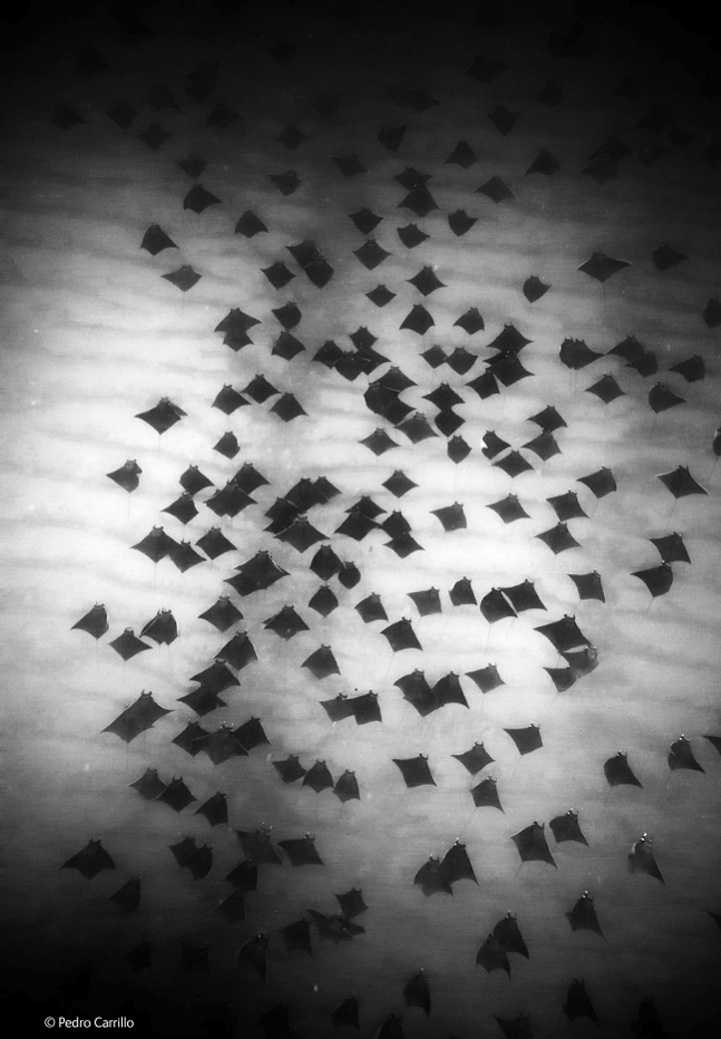 Ray Rhythm
Ray Rhythm
Pedro travelled to the Cabo Pulmo National Marine Park off the east coast of Mexico's Baja California Peninsula to see the thousands of mobula rays that gather there each winter. ‘I wanted to raise awareness of these impressive creatures, which are increasingly being targeted by fishermen,' says Pedro. His plan was to photograph them underwater while diving, but as he was snorkelling during a surface break he spotted an opportunity for a different composition. Although visibility was poor at the surface – 20 metres of murky water lay between Pedro and the rays swimming close to the bottom – the spectacle was impressive. It was perfect for a black-and-white composition. The 400 or more individuals, the largest school Pedro had ever seen, were moving as if they'd been choreographed. ‘To me this is a photograph about rhythm,' he explains, ‘the synchronous opening and closing of the rays' wings, their dark forms contrasting with the delicately textured white sand'.
Photo: Pedro Carrillo, Spain
Winner, Natural Design
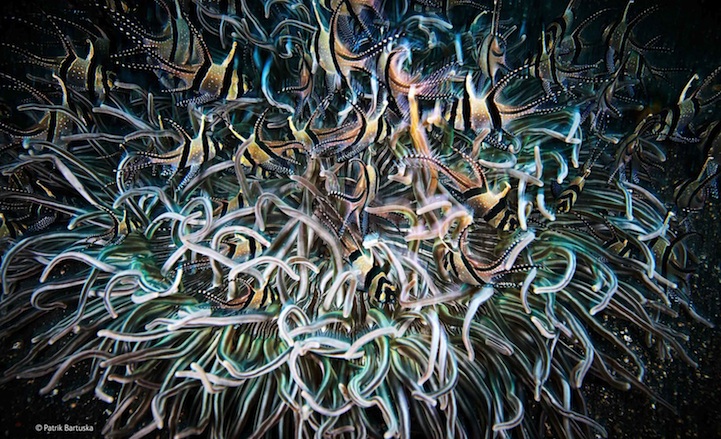
The Cardinal Sparks
Patrik's goal was to photograph a group of beautiful Banggai cardinalfish, which are found only in the waters off Sulawesi, Indonesia. They are endangered because of overfishing for the aquarium trade. Patrik encountered this scene while diving in the Lembeh Strait to the north. The contrasts of movement and texture entranced him – the anemone's soft tentacles swaying in the current and the flicks of the angular, patterned fish sheltering within them. During his trip he mostly came across small groups of adults gathered around the coral. But he was after a group associating with an anemone. During the day juveniles use the anemones' tentacles for protection, either avoiding their stings or being in some way unaffected by them. It took many dives before he found this large grouping. It appeared to Patrik like an underwater fire display, the tentacles like licking flames and the fish like erratic sparks. To capture the moving pattern he chose to shoot from above. Holding his position in the current, he waited for the fish to move so he could frame the composition.
Photo: Patrik Bartuska, Czech Republic
Finalist, Natural Design 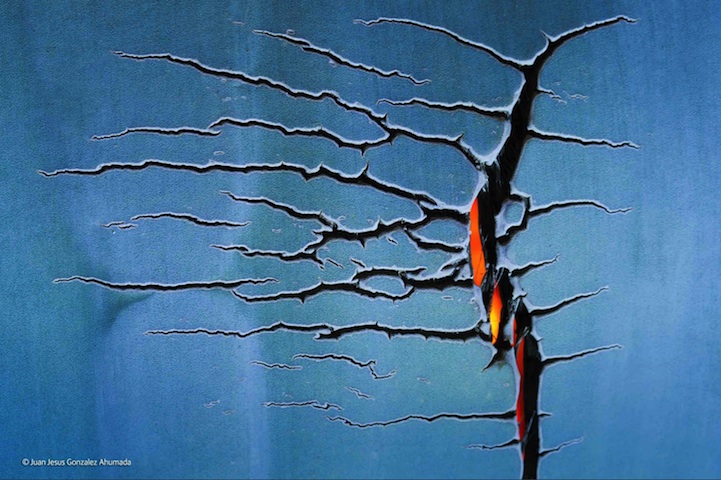 Cool Heat
Cool Heat
Juan had marvelled at the pattern caused by a crack in a huge agave leaf. The succulent was growing near his parents' house in Sierra Blanca, southern Spain. As the weighty leaf had grown it had curved over and started to split. Now it was about to be destroyed in a controlled burn, lit to prevent flash fires in summer. Juan was struck by the contrast between the cool blue of the leaf and the warm light from the fire ‘seeping through the wound'. He had to work quickly – its colour was darkening and its smooth texture deteriorating fast in the heat. He used a cool white balance to enhance the leaf's blue tone, and opted for a flash from the side to emphasise the cracks and give more contrast in the early evening light. But he managed just a few shots before the effect he wanted – ‘like a sheet of ice with fire below' – was spoiled by the blaze.
Photo: Juan Jesus Gonzalez Ahumada, Spain
Finalist, Natural Design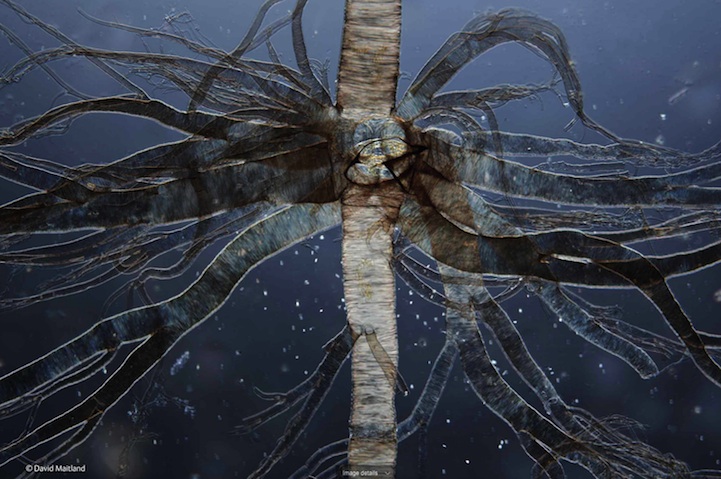 The Tracheal Tree
The Tracheal Tree
David describes the dissected trachea of a silkmoth caterpillar as ‘a Medusa from another world'. The trachea acts as an insect's lungs. The branched network of tubes delivers oxygen directly to every part of the body. The tiny passageways are prevented from collapsing by hoops of chitin, a substance that gives them a ridged appearance (an insect's exoskeleton is also made up of chitin). ‘I find the fine structure of nature fascinating,' says David. He captured this image from an old Edwardian microscope slide, using the very high magnification of a light microscope. ‘Once I had selected the frame of view, the main challenge was to adjust the lighting to create the atmosphere that I wanted.' Working with a very shallow depth of field and little light, he revealed the exquisite detail of a caterpillar's life-support system, which would normally be invisible to our eyes.
Photo: David Maitland, United Kingdom
Winner, World in Our Hands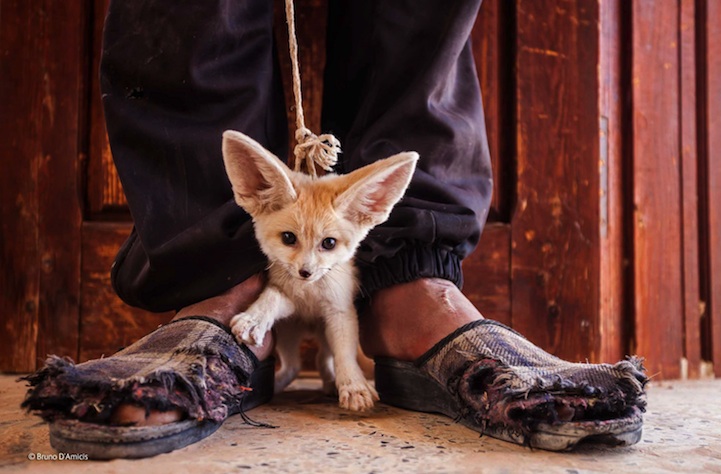 The Price They Pay
The Price They Pay
Bruno found a teenager selling a three-month-old fennec fox in a village in southern Tunisia. The pup was from a litter that he had dug out of a den in the Sahara Desert. Catching or killing wild fennec foxes is illegal in Tunisia, but it is still widespread. Bruno was working on a long-term project to investigate the issues facing endangered species in the Sahara. He gained the confidence of villagers in Tunisia, Algeria and Morocco and discovered widespread wildlife exploitation, including the hunting and capture for commercial trade and traditional medicine. He also discovered that the causes, and therefore the solutions, are complex. Contributory factors include high unemployment, poor education, lack of enforcement of conservation laws, ignorant tourists and tour companies, habitat destruction, and the sociopolitical legacy of the Arab Spring revolts. But Bruno is convinced that change is possible. He believes that thought-provoking images can help raise awareness among tourists and highlight what's happening to the Sahara's fragile environment.
Photo: Bruno D'Amicis, Italy
Winner, Special Award: Rising Star Portfolio Award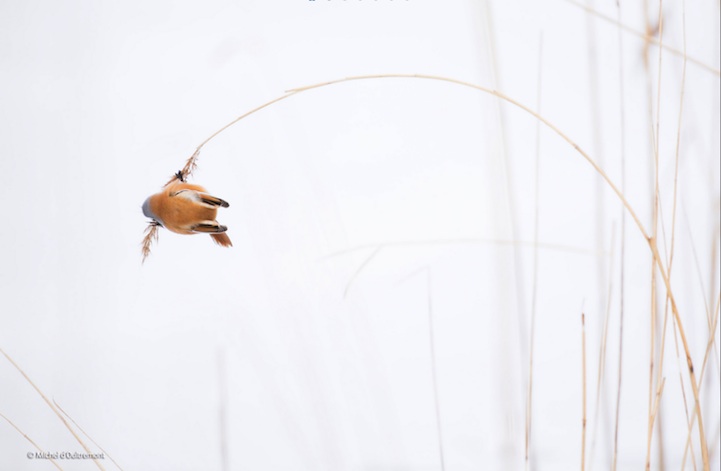 Feather Heavy
Feather Heavy
In winter, when there are few insects about, bearded tits feed mainly on reed seeds. Michel heard that a flock of them had congregated in a reed bed on a frozen lake near Rotterdam. As he walked into the reed bed, he first heard the ‘ping' calls of the tits, before finally spotting a tiny bird on a bobbing reed head. This shot was one of the rare moments when the view was clear, the reed had stopped swaying, and the colours of the male's beautiful plumage were in full view.
Photo: Michel d'Oultremont, Belgium
Winner, Special Award: People's Choice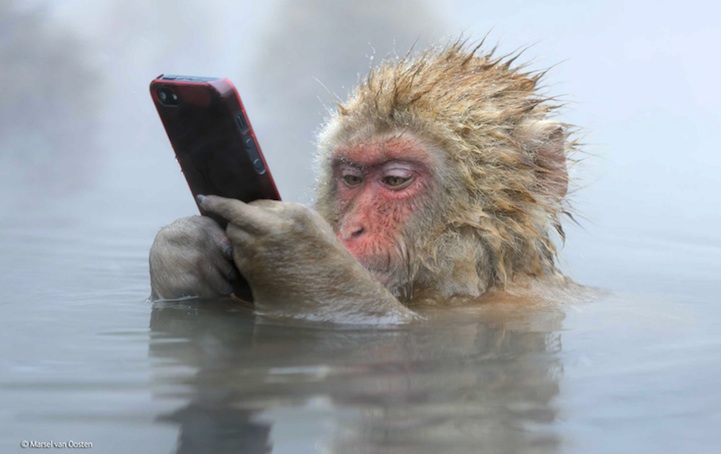 Facebook Update
Facebook Update
A tourist at Jigokudani Monkey Park, Japan, was so desperate to get a close-up of this young Japanese macaque in a natural hot spring that she held her phone ever nearer to her subject. Suddenly, the monkey snatched the device from her hand and retreated to the middle of the water to examine its prize. Marsel, who was leading a photographic tour at the time, saw the chance for a striking picture. His main challenge was the steam rising from the 42C water into the freezing air. ‘I wanted a really low angle,' he explains, ‘but that meant getting close to the water. My lens was cold and kept fogging up, making focussing almost impossible.' At first, the macaque just fumbled with the gadget. It had no idea what it had stolen but was nonetheless pleased with its new toy. It even managed to let the built-in flash go off a few times. When it finally held the phone just as a human would, looking intently at the screen, Marsel was ready to capture the image he had envisaged. Japanese macaques are thought to display culture, where a learned behaviour (most famously washing food) is passed on to other troop members and their descendants. But it remains to be seen if future generations of tech-savvy macaques emerge.
Photo: Marsel van Oosten, The Netherlands
Finalist, 11-14 Years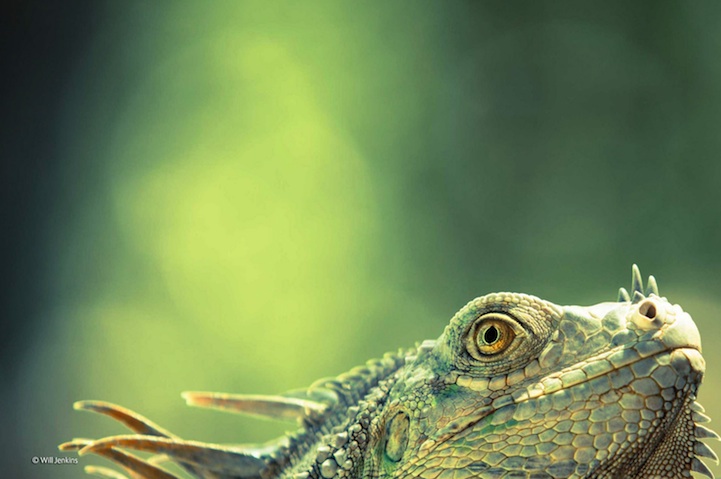 Green Dragon
Green Dragon
Relaxing at his hotel at the end of a Costa Rican family holiday, Will was planning to spend the day hanging out by the pool and surfing – until the green iguana jumped down from the hotel roof. Will grabbed his camera. ‘I love stories about dragons, and I wanted a big picture for my wall that would make me smile every day,' says Will. ‘I also wanted to impress my dad and brother with a shot of the biggest iguana I'd ever seen.' The metre-long lizard made its way to the top of a rock. Will edged closer. ‘I tried to keep to the shadows, hiding behind one sunbed, then the next, so as not to scare it.' Selecting a wide aperture to make his subject stand out, Will carefully focussed on its eye. ‘The iguana sunbathed for about 20 minutes before heading to the beach. It made me realise you should always have your camera with you, just in case.'
Photo: Will Jenkins, United Kingdom
Finalist, 11-14 Years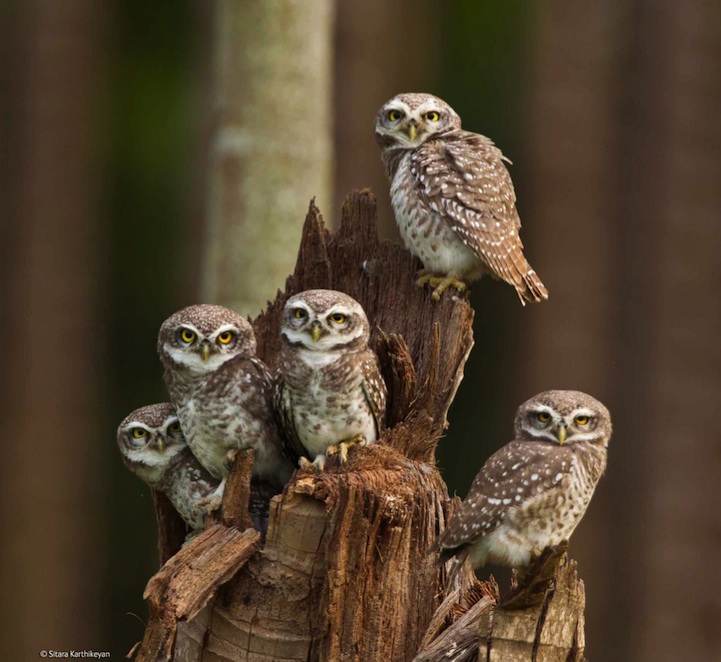 Owlets United
Owlets United
When photographing waterbirds by a coconut grove in southern India, Sitara was excited to see three spotted owlets perched on a dead tree, preening one another. When a few mynas started to mob them, the owlets let out a shrill call. Quickly, two adults joined the young, and all five stood their ground. ‘I was moved by their togetherness when in danger,' says Sitara, ‘and I wanted to capture the feeling'. To get an eye-level shot, she was forced to abandon her tripod and hand-hold the camera. This was ‘challenging,' she says, ‘as the lens was so heavy'. Selecting a wide aperture to blur the background, she focussed on the owls. Then, at the first click of the shutter, they all looked her way.
Photo: Sitara Karthikeyan, India
